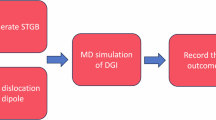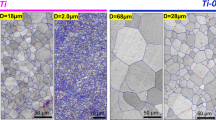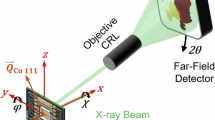Abstract
EXPERIMENTS on a number of body-centred cubic transition metals1 have shown that, above the ductile–brittle transition temperature, the yield stress, σy, varies with the average grain diameter, 2d, according to the relation:  Below the transition temperature, the brittle fracture stress, σf, is related to the grain size by the similar relation:
Below the transition temperature, the brittle fracture stress, σf, is related to the grain size by the similar relation: 
This is a preview of subscription content, access via your institution
Access options
Subscribe to this journal
Receive 51 print issues and online access
$199.00 per year
only $3.90 per issue
Buy this article
- Purchase on SpringerLink
- Instant access to full article PDF
Prices may be subject to local taxes which are calculated during checkout
Similar content being viewed by others
References
Johnson, A. A., J. Less-Common Metals, 2, 241 (1960).
Cottrell, A. H., Trans. Met. Soc. Amer. Inst. Mech. Eng., 212, 192 (1958).
Wronski, A. S., and Johnson, A. A. (unpublished results).
Vaughan, H. G., and Rose, R. G., Atomic Energy Authority Rep. IGR/TN/C–583 (1958).
Campbell, J. D., and Harding, J. (private communication).
Hull, D., and Mogford, I. L., Phil. Mag., 3, 1213 (1958).
Johnson, A. A., Phil. Mag., 5, 413 (1960).
Author information
Authors and Affiliations
Rights and permissions
About this article
Cite this article
JOHNSON, A. Theory of the Deformation and Fracture of Body-centred Cubic Transition Metals. Nature 189, 826–827 (1961). https://doi.org/10.1038/189826b0
Issue date:
DOI: https://doi.org/10.1038/189826b0



